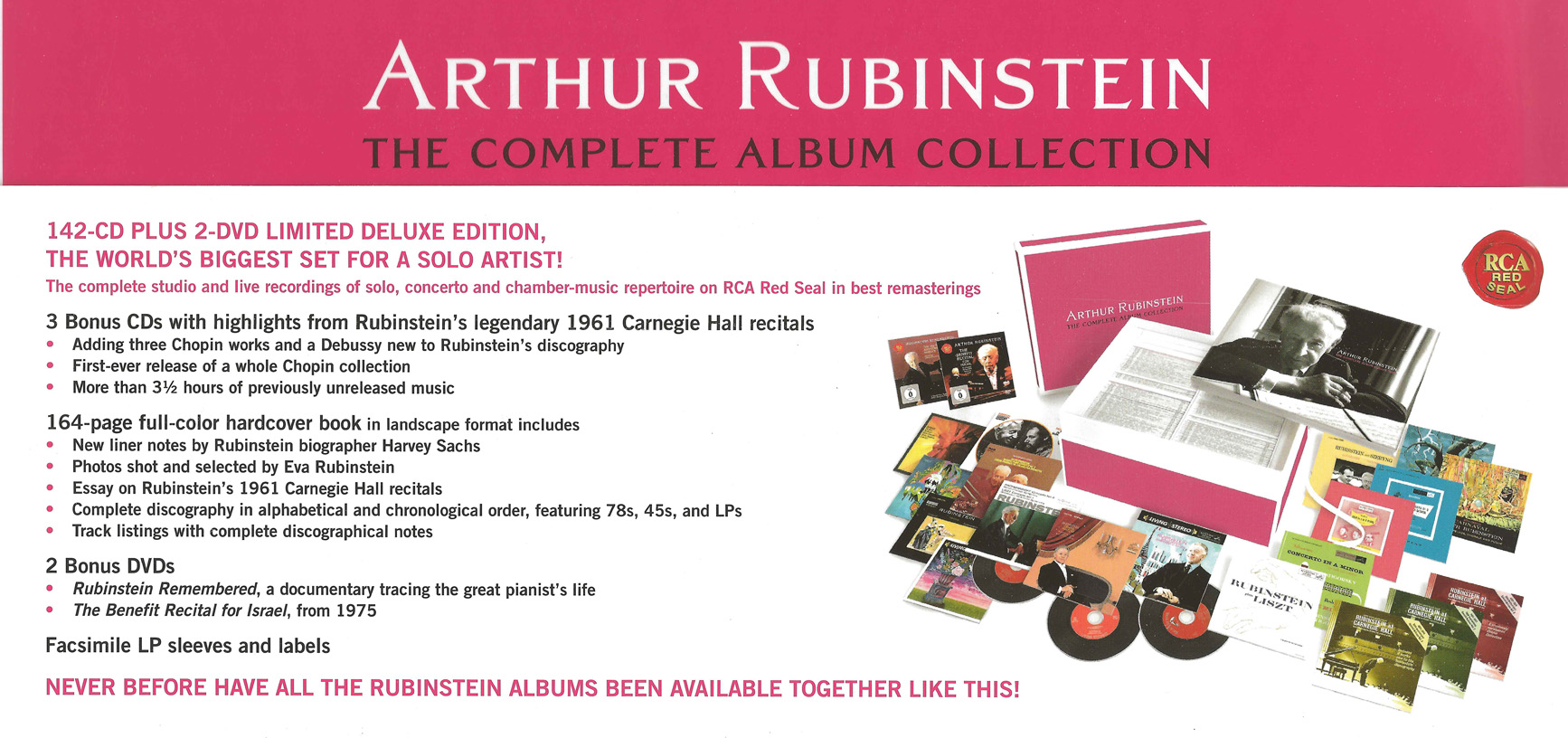Felix Mendelssohn Bartholdy
Piano Trio No.1 in D minor, op.49
Media Review / Comparison
2014-09-21 — Original posting (on Blogger)
2014-11-13 — Re-posting as is (WordPress)
2016-07-26 — Brushed up for better readability
Table of Contents
Introduction / The Recordings
This posting is about the Piano Trio No.1 in D minor, op.49 by Felix Mendelssohn Bartholdy (1809 – 1847). I currently have 3 recordings of this composition:
- Arthur Rubinstein, Jascha Haifetz, Gregor Piatigorsky (1950)
- Trio Wanderer (2006)
- Voces Intimae (2012)
The first recording above is part of the “Arthur Rubinstein Complete Album Collection“. I acquired the other two recordings in connection with my review of Mendelssohn Bartholdi’s Piano Trio No.2 in C minor, op.66.
Background, About the Composition
Felix Mendelssohn Bartholdy (1809 – 1847) wrote two piano trios. The first one, the Piano Trio No.1 in D minor, op.49 is a brilliant masterpiece from 1839, highly praised by his contemporaries. Robert Schumann called it “Masterwork of present time”. Mendelssohn first performed this with tremendous success in Leipzig, in 1840, after some more revisions. The composition has remained very popular to this day.
Mendelssohn’s second and final contribution to this genre, the Piano Trio No.2 in C minor, op.66 dates from 1845 and is less well-known than its predecessor, but equally fascinating. Both compositions deserve a prominent position in the concert repertoire. But both are equally challenging, particularly for the pianist.
The Movements
Mendelssohn’s Piano Trio No.1 in D minor, op.49 has four movements:
I. Molto allegro ed agitato, 3/4 (1/4 = 240)
As with op.66, the composition starts “in medias res”, without a real introduction. The cello introduces the theme which is later taken up by the violin. The form is that of a sonata movement. Almost throughout the movement, the piano plays a typical “Mendelssohnian”, busy accompaniment, often with a melody in the bass, as counterpoint to the string voices. The composer’s metronome mark is challenging for the pianist. However, after all, the annotation is Molto allegro and agitato. The movement is meant to be urging, pushing forward, in its passionate, emotional tone.
II. Andante con moto tranquillo, 4/4 (1/4 = 72)
This is a wonderful, lyrical Song without words: calm, serene, contemplative — apparently! There is a real danger that this gets pulled apart. If the violin adds too much vibrato, it turns more sweet (if not tearful) than the composer intended. Note that the annotation is Andante con moto tranquillo, i.e., walking, with calm movement. That goes along with a metronome value that is considerably faster than many (if not most) ensembles play.
It turns out that one can just as well have singing voices in the specified tempo, but the character changes from contemplative to more urging, emotional. Note that there isn’t a really slow movement in this composition! As for the nice “song” (without words): that still works also at the faster tempo. One should just not “sit down” on every quaver, but rather think the melody in quarter notes, as appropriate for a movement in 4/4.
III. Scherzo: Leggiero e vivace, 6/8 (3/8 = 120)
Literally every movement in this piece has a tempo issue! Here, the specified tempo is so fast that it’s virtually impossible to play on a modern concert grand. A good pianist may get close, but then, the fast passages easily tend to get blurred, if not superficial. This movement really calls for a fortepiano, a piano from Mendelssohn’s time! It’s just the same as with the Scherzo in op.66, where Mendelssohn himself stated that playing the Scherzo is “a little pesky”.
IV. Finale: Allegro assai appassionato, 4/4 (1/4 = 200)
Also this movement is typically heard substantially slower than specified. A real challenge for the musicians! But after all, it’s an Allegro (assai appassionato), not an Allegretto!
The Interpretations, Overview:
In order to provide a rating overview (ratings 1 .. 5), as well as an idea about tempo relations both within an interpretation, as well as between the two recordings, I have prepared the table below. The color coding for the tempo (blue = slower, green = faster) refers to the average between the recordings:Note that ratings are relative (by and large). A rating of 5 means “best within this selection”.
The Interpretations, Detail:
This comparison features interpretations from the same two CDs that were already discussed with the Piano Trio No.2 in C minor, op.66, plus a historic recording from 1950, which can hardly compete with modern ones, sound-wise. Overall, I now have three entirely different recordings, covering a span of 62 years:
Arthur Rubinstein, Jascha Haifetz, Gregor Piatigorsky
Arthur Rubinstein — The Complete Album Collection
CD #29: Mendelssohn: Piano Trio No.1 in D minor, op.49; Ravel: Piano Trio in A minor
Arthur Rubinstein, Jascha Haifetz, Gregor Piatigorsky
SONY Classical 88691936912 (142 CDs / 2 DVDs, mono / stereo); ℗ / © 2011
Documentation 162 pp., LP liner notes on back of CD sleeve

After the war, the three world-famous artists Arthur Rubinstein (1887 – 1982), Jascha Haifetz (1901 – 1987), and Gregor Piatigorsky (1903 – 1976) have made several recordings (as well as presumably concert appearances) as a piano trio. In 1950 they joined for recording the first piano trio by Mendelssohn, as well as Ravel’s piano trio. This of course is a mono recording; one that was brought out on LP directly. As one could expect, there are severe limitations in the sound technique and transparency / spatial resolution in this recording, compared to the more recent recordings below. Haifetz takes the freedom to add some “features”, such as a multiple-stop chord, for the purpose of “enhancing” / supporting accented peak notes.
I. Molto allegro ed agitato
Duration: 8’43”
If only the sound engineering had been better! This movement sounds like a violin sonata with the accompaniment of piano and cello: when it’s not having a solo, the cello is often hardly audible, and even the piano is (compared to Haifetz) pretty much in background and not very differentiated (unless Rubinstein is playing a solo, or the melody in the right hand). Overall, the balance is heavily distorted, the listening experience / pleasure rather limited. One can still gather, though, that Rubinstein’s playing is very virtuosic. He does not appear to have any problems with the piano part. Note that on average, all three ensembles in this comparison play about the same tempo, slightly slower than specified by Mendelssohn.
II. Andante con moto tranquillo
Duration: 6’24”
Even though this movement is still substantially slower than specified (see also the interpretation below), at least this is felt in crotchets, the quavers turn into notated ornaments. The character is closer to what Mendelssohn’s annotation suggests, though I would still claim this is Andante tranquillo, without the con moto. The balance is better than in the first movement. That’s primarily because both the cello and the piano have more prominent roles in this movement. The piano introduces the melodies. Expectedly, there is also some Zeitgeist, e.g., Haifetz’ prominent portamenti and the rather fast, omnipresent vibrato in both string instruments. But within limits, the vibrato in general still feels harmonious here and does not affect the intonation.
III. Scherzo, Leggiero e vivace
Duration: 3’30”
That’s about as fast as is possible on a modern piano. One actually notices one or the other superficial passage where the notes get blurred. As for the violin: that part is written spiccato, but with Haifetz this is rather harsh, woodcut-like, not really joyful, nor leggiero. Haifetz appears to have focused on the Scherzo aspect.
IV. Finale, Allegro assai appassionato
Duration: 8’03”
The main motif in this movement consists of a crotchet, followed by two spiccato quavers. Strangely, that is not articulated consequently in this interpretation: on the piano, the crotchet appears shortened compared to how it is performed on the string instrument. Also, the movement once again demonstrates that acoustic balance in this piece is a problem with modern instruments, compounded by limitations in the recording technique.
Overall Duration: 26’38”
Rating (see above for details): 3.3 — Definitely a valuable, historic document, a recording that many will rate very highly just for the artists. Besides that, it can’t really compete with modern recordings, let alone those with period instruments.
Trio Wanderer
Mendelssohn Bartholdy: Piano Trios 1 & 2
harmonia mundi HMA 1951961 (CD, stereo); ℗ 2007 / © 2013
Booklet: 8 pp. f/e/d

The Trio Wanderer (Vincent Coq, piano; Jean-Marc Philips-Varjabédian, violin; Raphaël Pidoux, cello) was founded around 1987. For general information on this ensemble see my posting “Mendelssohn: Piano Trio No.2 in C minor, op.66“. This recording was made in September 2006.
I. Molto allegro ed agitato
Duration: 8’46”
In this recording, the sound per se is not the problem: a warm, full sound, well-rounded from this ensemble. However, this recording reveals the inherent problem with playing Mendelssohn piano trios on modern instruments. Particularly with a modern concert grand, it does not offer the necessary clarity and transparency with the agitated, busy texture of the piano part. Often, the piano accompaniment is somewhat diffuse (even “washed out”), the cello is sometimes hard to follow. In the beginning, the strings are rather loud, not p; finally, the vibrato in the violin has a rather high amplitude, sometimes affecting the intonation. On the bright side, I like their agogics, e.g., the occasional, little ritardando preceding a climax in a phrase.
II. Andante con moto tranquillo
Duration: 6’36”
Very nice, cantabile — but too much derived from a contemplative type of Lied. The tempo is definitely too slow, not just from the metronome reading. The overall impression is Adagio tranquillo at best when heard in crotchets. When listening to this interpretation, one tends to hear quavers. It’s an inherent danger with this movement, to take it too slow, to take a plunge in harmony and well-feeling! The one very nice moment in this interpretation is the little cadenza at the end, where the transition from the violin to the cello and back, is really seamless, perfect!
III. Scherzo, Leggiero e vivace
Duration: 3’27”
As with Rubinstein / Haifetz / Piatigorsky, the tempo is at the limit of what a modern piano can do. The articulation is occasionally slightly superficial. Also, the tempo often feels a bit pushed (as if the artists reminded themselves periodically to stick to the intended metronome value?). In my opinion, the real art here would be to play this as fast as possible, but still in a range that permits making this appear light, almost casual, not stressed out!
IV. Finale, Allegro assai appassionato
Duration: 8’11”
Slow compared to Mendelssohn’s metronome rate; actually, at the same tempo as Rubinstein / Haifetz / Piatigorsky. But again, this is at the limits of what is doable on modern instruments. The piano part lacks transparency, especially for the left hand. At the same time, the tempo sometimes feeling pushed, see also the previous movement.
Overall Duration: 26’59”
Rating (see above for details): 3.8 — A very good, conventional interpretation, overall, with good, warm sound. Its main “deficiencies” lay in the difficulty with playing Mendelssohn’s piano scores on a modern instrument. And, for my taste, in the strong vibrato in the violin, sometimes causing intonation issues.
Voces Intimae
Mendelssohn Bartholdy: Piano Trios 1 & 2; Schubert: Piano Trios opp.99 & 100
Pan Classics PC 10263 (2 CDs, stereo); ℗ 1999/2002 / © 2012
Booklet: 15 pp. d/e/f

For general information and remarks on the ensemble Voces Intimae (Riccardo Cecchetti, fortepiano; Luigi de Filippi, violin; Sandro Meo, cello) see my posting “Mendelssohn: Piano Trio No.2 in C minor, op.66“. This recording was made in 2012, on period instruments. The piano is a fortepiano by Joseph Worel (Vienna, ca. 1829), the violin is by Antonio Mariani (Pesaro, 1648), the cello by Mattia Albani (Bolzano, 1702).
I. Molto allegro ed agitato
Duration: 8’38”
The fortepiano “naturally” solves all balance issues caused by modern instruments. The string instruments are partners with equal rights, and the also transparency is much better! Here now one can hear those rumbling piano trills in the bass, and the piano part remains clear and transparent even in the fastest passages — maybe with the minor (rare in this movement) exception where the pianist obscures the articulation with arpeggiando articulation. Excellent, overall.
II. Andante con moto tranquillo
Duration: 5’48”
Finally, a version that honors the annotation Andante con moto tranquillo. And it is very close to Mendelssohn’s metronome annotation! This really is an Andante con moto, while the overall character matches the tranquillo annotation, even though on a small scale, there are many moments where the motifs have “forward drive”! Interestingly (and unexpectedly), the pianist uses less arpeggiando here than in some of the fast movements. Excellent, both serene and very expressive, though in a very different way than with the Trio Wanderer. As trivial as it sounds, one must keep in mind: it’s not an Adagio!
III. Scherzo, Leggiero e vivace
Duration: 3’28”
The charter of this ensemble (in this Mendelssohn recording) was, to prove that Mendelssohn’s tempi can indeed be played, using period instruments. Here, they indeed come closer than the interpretations on modern instruments, and amazingly, the transparency, clarity, and the acoustic balance in the piano part is better than with a modern concert grand. Plus, the interpretation does sound playful, even though they, too, operate at the limits!
IV. Finale, Allegro assai appassionato
Duration: 7’18”
Very close to Mendelssohn’s tempo specification, and again played at the limits of feeling pushed / rushed — maybe more here than in previous movements. If given a choice between the specified tempo that feels pushed, and a more moderate one that doesn’t, then I’d select the latter. It’s hard to tell here whether the limits are with the pianist or with the mechanics of the period instrument.
Overall Duration: 25’08”
Rating (see above for details): 4.8 — If you expect a “traditional” interpretation (slower, conventional tempo, warm, cosy sound), then this isn’t for you. But if you are open to a fresh view that comes close to what this may have sounded like in Mendelssohn’s private concert room (if you are ever close to Leipzig and haven’t visited Mendelssohn’s last apartment yet, I urge you to do so!), I can definitely recommend this recording!
Addendum
Mendelssohn’s Piano Trio No.1 in D minor, op.49 was featured in a chamber music concert at the Tonhalle in Zurich, with Yuja Wang, Klaidi Sahatçi, and Thomas Grossenbacher. See my concert review in the posting “Yuja Wang, Tonhalle Zurich, 2014-09-14“.










